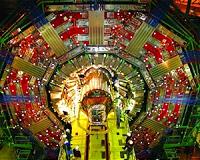 |
Bonn, Germany (SPX) Nov 26, 2010 Physicists from the University of Bonn have developed a completely new source of light, a so-called Bose-Einstein condensate consisting of photons. Until recently, expert had thought this impossible. This method may potentially be suitable for designing novel light sources resembling lasers that work in the x-ray range. Among other applications, they might allow building more powerful computer chips. The scientists are reporting on their discovery in the upcoming issue of the journal Nature. By cooling Rubidium atoms deeply and concentrating a sufficient number of them in a compact space, they suddenly become indistinguishable. They behave like a single huge "super particle." Physicists call this a Bose-Einstein condensate. For "light particles," or photons, this should also work. Unfortunately, this idea faces a fundamental problem. When photons are "cooled down," they disappear. Until a few months ago, it seemed impossible to cool light while concentrating it at the same time. The Bonn physicists Jan Klars, Julian Schmitt, Dr. Frank Vewinger, and Professor Dr. Martin Weitz have, however, succeeded in doing this - a minor sensation.
How warm is light? Blue light is warmer than red light, but tungsten glows differently than iron, for example. This is why physicists calibrate color temperature based on a theoretical model object, a so-called black body. If this body were heated to a temperature of 5,500 centigrade, it would have about the same color as sunlight at noon. In other words: noon light has a temperature of 5,500 degrees Celsius or not quite 5,800 Kelvin (the Kelvin scale does not know any negative values; instead, it starts at absolute zero or -273 centigrade; consequently, Kelvin values are always 273 degrees higher than the corresponding Celsius values). When a black body is cooled down, it will at some point radiate no longer in the visible range; instead, it will only give off invisible infrared photons. At the same time, its radiation intensity will decrease. The number of photons becomes smaller as the temperature falls. This is what makes it so difficult to get the quantity of cool photons that is required for Bose-Einstein condensation to occur. And yet, the Bonn researchers succeeded by using two highly reflective mirrors between which they kept bouncing a light beam back and forth. Between the reflective surfaces there were dissolved pigment molecules with which the photons collided periodically. In these collisions, the molecules 'swallowed' the photons and then 'spit' them out again. "During this process, the photons assumed the temperature of the fluid," explained Professor Weitz. "They cooled each other off to room temperature this way, and they did it without getting lost in the process."
A condensate made of light This photonic Bose-Einstein condensate is a completely new source of light that has characteristics resembling lasers. But compared to lasers, they have a decisive advantage, "We are currently not capable of producing lasers that generate very short-wave light - i.e. in the UV or X-ray range," explained Jan Klars. "With a photonic Bose-Einstein condensate this should, however, be possible." This prospect should primarily please chip designers. They use laser light for etching logic circuits into their semiconductor materials. How fine these structures can be is limited by the wavelength of the light, among other factors. Long-wavelength lasers are less well suited to precision work than short-wavelength ones - it is as if you tried to sign a letter with a paintbrush. X-ray radiation has a much shorter wavelength than visible light. In principle, X-ray lasers should thus allow applying much more complex circuits on the same silicon surface. This would allow creating a new generation of high-performance chips - and consequently, more powerful computers for end users. The process could also be useful in other applications such as spectroscopy or photovoltaics.
Share This Article With Planet Earth
Related Links University of Bonn Understanding Time and Space
 Magnetic Trapping Will Help Unlock The Secrets Of Anti-Matter
Magnetic Trapping Will Help Unlock The Secrets Of Anti-MatterLondon, UK (SPX) Nov 24, 2010 A clearer understanding of the Universe, its origins and maybe even its destiny is a significant step closer, thanks to new research. As part of a major international experiment called ALPHA, based at CERN in Switzerland, researchers have helped to achieve trapping and holding atoms of 'anti-hydrogen', which has not previously been possible. The project involves physicists at Swansea Unive ... read more |
|
| The content herein, unless otherwise known to be public domain, are Copyright 1995-2010 - SpaceDaily. AFP and UPI Wire Stories are copyright Agence France-Presse and United Press International. ESA Portal Reports are copyright European Space Agency. All NASA sourced material is public domain. Additional copyrights may apply in whole or part to other bona fide parties. Advertising does not imply endorsement,agreement or approval of any opinions, statements or information provided by SpaceDaily on any Web page published or hosted by SpaceDaily. Privacy Statement |